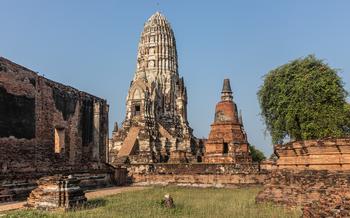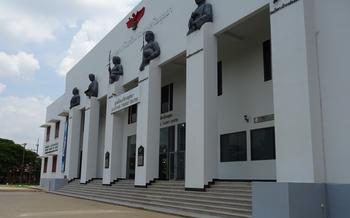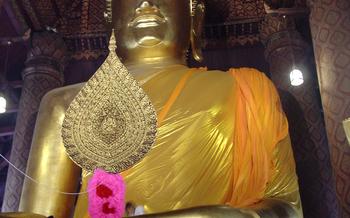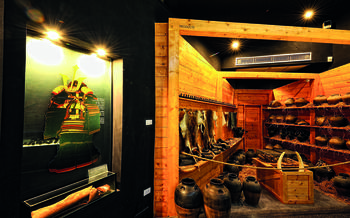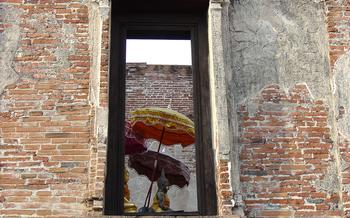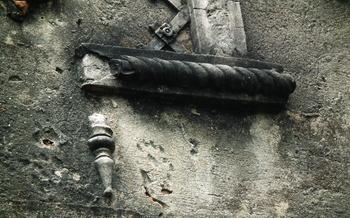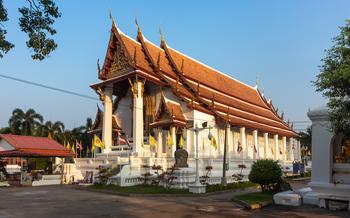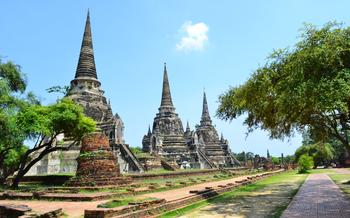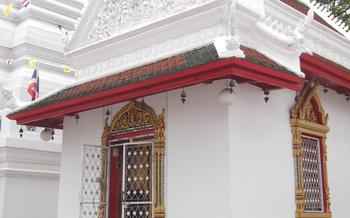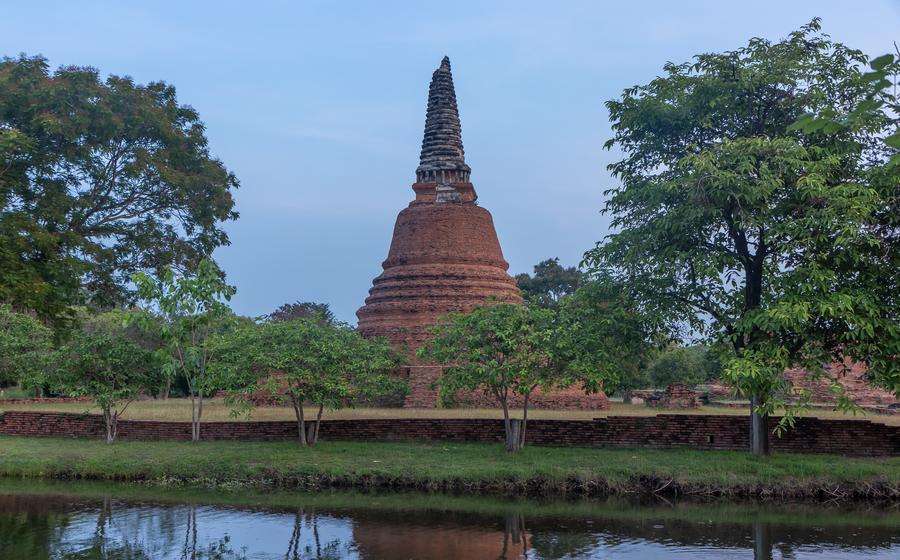
Wat Phra Merurachikaram
- The Ordination Hall
- The Phra Viharn Yai
- History of the Viharn
- Architectural Features
- Buddha Images and Murals
- The Phra Prang
- The Phra Mongkhon Bophit
- The Phra Buddha Saiyas
- Insider Tip: Experiencing the Temple's Atmosphere
The Ordination Hall
The ordination hall, known as Ubosot, is the most sacred structure within the Wat Phra Merurachikaram temple complex. It is the site where monks are ordained and important Buddhist ceremonies are held. The Ubosot at Wat Phra Merurachikaram is a magnificent example of Ayutthaya architecture, featuring a tiered roof with intricate carvings and decorations. The walls of the hall are adorned with beautiful murals depicting scenes from the life of Buddha and the history of Thailand.
Inside the ordination hall, visitors can admire the Phra Buddha Sihing, a highly revered Buddha image believed to date back to the 13th century. The Phra Buddha Sihing is known for its serene expression and exquisite craftsmanship. It is considered one of the most important Buddha images in Thailand and is a major pilgrimage site for Thai Buddhists.
The ordination hall also houses a number of other important artifacts, including ancient manuscripts, religious objects, and royal regalia. These artifacts provide visitors with a glimpse into the rich history and cultural significance of the temple.
The Phra Viharn Yai
The Phra Viharn Yai, also known as the Grand Viharn, is a stunning edifice located within the temple grounds of Wat Phra Merurachikaram. Completed in 1357 during the reign of King Uthong, this remarkable structure has stood the test of time and remains an architectural masterpiece.
History of the Viharn
Constructed as a royal chapel, the Phra Viharn Yai played a significant role in the religious ceremonies of the Ayutthaya Kingdom. It served as a sacred space where the royal family and high-ranking officials would gather for important Buddhist rituals and festivals.
Architectural Features
The Phra Viharn Yai showcases a unique blend of architectural styles, reflecting the diverse influences that shaped Ayutthaya's artistic heritage. Its striking features include a soaring prang, intricate stucco decorations, and elegant archways adorned with delicate floral motifs.
Buddha Images and Murals
The interior of the Phra Viharn Yai is adorned with a collection of exquisite Buddha images, each exuding a sense of serenity and divine presence. The walls are adorned with vibrant murals depicting scenes from the life of Buddha, offering visitors a glimpse into the rich tapestry of Buddhist mythology.
The Phra Prang
The Phra Prang is the most striking structure in the Wat Phra Merurachikaram complex, a majestic and towering prang that dominates the skyline and has made the temple a renowned landmark. Built in the Ayutthaya architectural style, the Phra Prang features a distinctive design that incorporates three distinct sections: the base, the body, and the spire. The base, which is square in shape, features intricate carvings and moldings that showcase the exceptional craftsmanship of the temple's builders. The body, which rises from the base, displays a series of niches, each housing a Buddha image in a seated posture. The spire, which is the crowning glory of the Phra Prang, rises elegantly towards the sky, adorned with intricate decorative elements that add to its grandeur and magnificence.
The Phra Prang is not merely an architectural masterpiece; it also holds profound symbolic meaning in Buddhism. In Buddhist cosmology, the prang represents Mount Meru, the sacred mountain that is believed to be the center of the universe. It is said that the Buddha attained enlightenment while meditating on Mount Meru, and the construction of prangs in Buddhist temples symbolizes the Buddha's presence. Moreover, the Phra Prang at Wat Phra Merurachikaram serves as a reminder of the temple's historical significance, as it was built during the reign of King Naresuan, a revered Thai monarch who played a crucial role in the kingdom's defense against Burmese invasions.
The Phra Mongkhon Bophit
The Phra Mongkhon Bophit is one of the most revered Buddha images in Thailand and a symbol of Ayutthaya's rich history. Enshrined within the Phra Viharn Yai, this colossal bronze statue stands at an impressive height of 45 meters and exudes an aura of serenity and grandeur.
Crafted during the reign of King Mongkut (Rama IV) in the 19th century, the Phra Mongkhon Bophit embodies the artistic prowess and devotion of the Ayutthaya Kingdom. Its name, which translates to "Buddha of Auspicious Glory," reflects the deep reverence and admiration held for this sacred image.
The Buddha is depicted in a seated meditation posture, known as the "samadhi" position, with his right hand raised in the gesture of reassurance and protection, while his left hand rests gracefully in his lap. The intricate detailing and lifelike features of the statue showcase the exceptional craftsmanship of the artisans who created it.
The Phra Mongkhon Bophit holds a special place in the hearts of Thai people and is considered a powerful symbol of good fortune and prosperity. Devotees from all over the country flock to the temple to pay homage to this revered image, seeking blessings, guidance, and spiritual fulfillment.
The Phra Buddha Saiyas
The Phra Buddha Saiyas is another significant Buddha image enshrined within the temple grounds. Its history dates back to the Ayutthaya period, where it was originally housed in a temple in the ancient city of Phitsanulok. During the Burmese invasion of Ayutthaya in the 18th century, the image was brought to Wat Phra Merurachikaram for safekeeping.
Crafted from bronze, the Phra Buddha Saiyas exudes a serene and majestic aura. It depicts the Buddha in a seated posture, with his right hand raised in the abhaya mudra, a gesture of reassurance and protection. The image showcases the intricate artistic style of the Ayutthaya period, characterized by its graceful lines and delicate features.
The Phra Buddha Saiyas holds a special place in Thai Buddhism, as it is believed to possess potent protective powers. Devotees often come to the temple to pay homage to the image, seeking blessings for safety, good health, and prosperity.
Insider Tip: Experiencing the Temple's Atmosphere
To fully immerse yourself in the sacred atmosphere of Wat Phra Merurachikaram, it's essential to visit during the early morning or late afternoon, when the sunlight casts a golden glow on the temple grounds, creating a serene and contemplative ambiance. Remember to dress modestly, covering your shoulders and knees, as a sign of respect for the temple's religious significance. If you're fortunate enough to witness a Buddhist ceremony, take the opportunity to observe the rituals and traditions that have been passed down for generations. The monks' chanting, the rhythmic sound of drums, and the scent of incense will transport you to a realm of spiritual tranquility, leaving you with a profound sense of peace and serenity.
